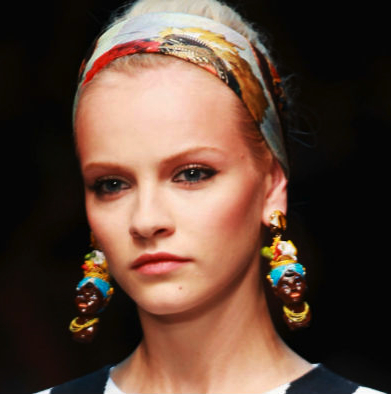Dolce & Gabbana responds to accusations that ‘Blackamoor’ earrings are racist
Share
Explore Our Galleries
Breaking News!
Today's news and culture by Black and other reporters in the Black and mainstream media.
Ways to Support ABHM?
By Alexis Garrett Stodghill, Huffington Post
After causing an international uproar by sending what many deem to be racist imagery down their runway, Dolce & Gabanna have responded indirectly to the firestorm through their style blog Swide.
The Spring 2013 collection of the beloved fashion house included ‘Blackamoor’ or ‘Moorish’ symbolism in the form of the heads of black women used in dangling earrings and on the printed fabrics of dresses….Dolce & Gabanna tried to explain that for Sicilians these colorful echoes of Blackamoor decorative arts are merely part of the culture of their native land.
“You might have seen them in some villa or restaurant or hotel in Sicily, dominating the table: colourful head-shaped ceramic vases filled with beautiful flowers,” the article on Swide fancifully relates. “But like many things in Italy, they are more than what they seem….Despite this, the relationship between this use of black people in decorative arts and stereotypes such as Mammy, Sambo, and the dehumanizing Golliwogg doll cannot be denied. The use of people of African decent as fashionable accents is seen by most to be demeaning, particularly because the practice originated during an age when such people were considered inferior.
As The Huffington Post explains, Dolce & Gabbana might think all things ‘Moorish’ are festive, but – ”the images are also seen as taboo, offensive and racially insensitive. The Mammy-looking figures recall a past of slavery and servitude that many don’t want to be reminded of — especially via a fashion statement.”
Read more here.












Comments Are Welcome
Note: We moderate submissions in order to create a space for meaningful dialogue, a space where museum visitors – adults and youth –– can exchange informed, thoughtful, and relevant comments that add value to our exhibits.
Racial slurs, personal attacks, obscenity, profanity, and SHOUTING do not meet the above standard. Such comments are posted in the exhibit Hateful Speech. Commercial promotions, impersonations, and incoherent comments likewise fail to meet our goals, so will not be posted. Submissions longer than 120 words will be shortened.
See our full Comments Policy here.